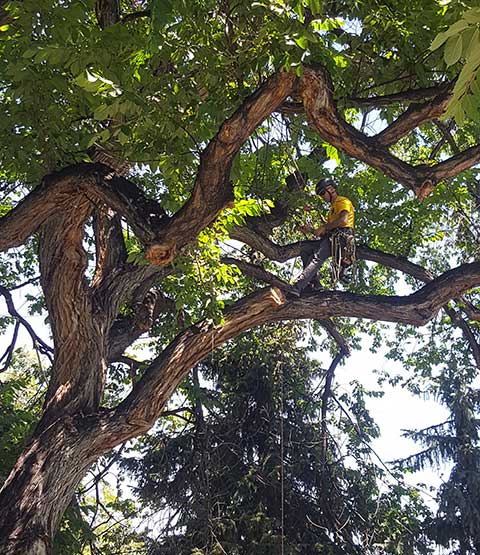Whether you have trees in your front yard or you live in a community that has many trees, it’s important that you understand the benefits of tree trimming and pruning. By removing dead or damaged branches and making sure that there are no diseased trees or bushes, you will be able to protect your landscape from a number of problems. This will help your plants to grow and will also help prevent diseases from spreading to other areas of your landscape.
Removing dead or damaged branches
Keeping trees healthy by removing dead or damaged branches can help prevent damage. A damaged or dead tree can be dangerous and interfere with people, vehicles, and signs. It can also grow into utility wires and cause property damage.
When a tree begins to exhibit decaying signs, it should be removed immediately. It can be a sign of internal decay, or a symptom of root damage. This condition is especially dangerous when there are broken limbs. It can also be a warning that there is a problem with the trunk. If you are concerned, contact a certified arborist.
Keeping trees healthy and free from damage is an important part of maintaining the value of your home. Pruning can help to prevent rot, and remove diseased or damaged branches. Trees can also be trained to a specific shape. This can reduce future maintenance costs.
Trees are typically pruned at different times of the year, depending on the type of tree. Fruit trees should be pruned in the late winter, while ornamental trees can be pruned in the early spring.

Preventing disease from spreading to the rest of the landscape
Getting your tree trimming and pruning right is a worthwhile endeavor. A well maintained landscape can go a long way towards creating a healthy, productive, and beautiful space. The best way to ensure that you get it right is to hire the right people, get the right training and buy the right tools. Luckily, there are some great resources available on the web that can help you choose the right tree trimmer and pruner for your needs.
For example, if you live in a city, chances are you will be able to hire someone to come out to your house, do a quick assessment of your trees and recommend a maintenance plan for your landscaping needs. For example, if your trees are in close proximity to your house or other buildings, pruning them up will not only help reduce the risk of limbs falling on unsuspecting pedestrians, but also reduce friction on the walls of your building.
Reducing root loss
Whether your property has an existing tree or you’ve just planted a new one, reducing root loss through pruning and trimming is a smart way to promote the longevity of your investment. It also increases the visual appeal of your landscape. Regardless of the type of tree, trimming and pruning can increase air circulation, reduce weak branches and increase the overall health of your plant.
The first step in reducing root loss is to determine what you want to achieve. This may involve removing dead limbs, pruning a few branches to improve the shape, or removing a whole tree. It may also involve installing cables or screw rods to hold branches in place.
The most basic approach to pruning is to remove dead or dying branches. This helps prevent decay and reduces the risk of injury. Often, pruning can be performed in the fall or winter months, but it is best to avoid pruning during the hot, dry months of summer.
Helping plants grow
Whether you’re a gardener or you’re just looking to beautify your home, there are many ways to help plants grow. Tree trimming and pruning are both very important, and the right pruning techniques can have a huge impact on the health of your plants. With some careful planning and a little knowledge, you can ensure that your trees remain healthy and beautiful.
Tree trimming is the process of cutting back overgrown branches and stems. It helps promote proper plant growth, and is also helpful in preventing insect damage and controlling plant diseases. If you’re not sure what to do, you should consult a good book or your county extension office.
If your plant has a lot of dead or diseased branches, it’s best to prune them. Dead branches can serve as entry points for pests and diseases, and can also weaken the structure of the plant. They can even spread diseases to the rest of the plant. Pruning dead branches will also help the plant focus on new growth, and will prevent insects from causing damage.